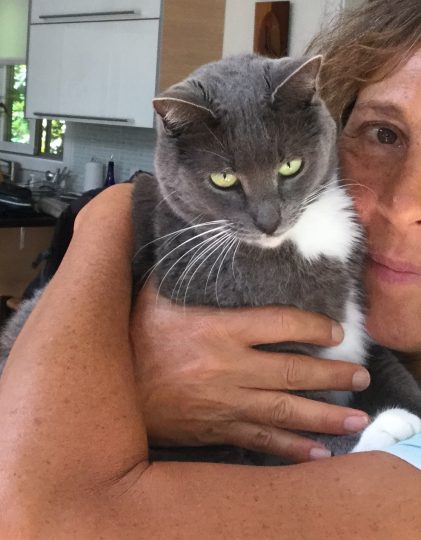Everyone knows about Siamese cats, including people not particularly interested in cats. Siamese cats have a distinctive appearance and a reputation for being quite talkative. But I wanted to know more about them.
What causes Siamese cats markings?
Siamese cats are pointed cats, which creates their distinctive look.
-
-
- a pointed cat is a cat that has a face, paws, and tail darker than the rest of their body. This coloring are on the extremities of the cat, hence the “points” of the cat.
-
The pointed colouring is from a mutated enzyme used in the production of melanin. This enzyme is sensitive to heat and becomes active in the coolest parts of the cats skin. This means that the breed have dark coloration in the coolest parts of their body (the face, paws and tail). The breed differ in colour depending on the climate. Hot locales generally produce lighter coats than cold climates.
from the-cat-guide.com
Siamese cats are generally healthy, but are more prone to cancer, caused by neoplasia, than most other breeds.
There are four primary types of Siamese cats based on points and body color. The early Siamese cats were all seal points and in 1906 the CFA (Cat Fanciers Association) recognized the breed as one of the first pedigree cat. Initially, even after other variations of point colors were bred, the CFA only recognized seal points.
- Seal Points have dark or seal brown, nearly black points. Their body color ranges from light brown to ivory
-
- Chocolate Points have milk chocolate points and legs, their bodies taper a pale white
- Blue Points have blue-gray points, the body is light gray or beige. Recognized by the CFA (Cat Fancier Association) in 1934
- Lilac Points have pink-gray points and a white body. They were recognized by the CFA in 1955
All Siamese kittens are completely white when they are born. The points that display which type of Siamese they are appear about the same time their eyes start to open, which is about three weeks. .

When kittens open their eyes, all breeds are born with blue eyes, but Siamese keep their blue eyes as adults.The original Siamese cat was quite different from modern ones. The earlier Siamese were rounder, stockier, and looked sturdier. Their heads were rounder, and all were seal points. Once Siamese were exhibited at cat shows the standard changed for competition. Siamese cats look became slim, elongated, more delicate.
These days there are also red pointed Siamese, tabby pointed, tortie pointed, plus cream, apricot, cinnamon, and a whole range of other colors. Although many people are returning to the older Siamese characteristics.
Where did Siamese cats come from?
Siamese are considered the earliest breed of cat. It’s believed that Siamese are descended from the sacred temple cats in Siam, now called Thailand. A Siamese manuscript Cat-Book Poems, written sometime after 1350, had pictures of a Seal Point cat.
The first documented import of a Siamese cat shipped to an American was to Mrs. Lucy Webb Hayes, wife of President Hayes, by the U.S. Consul, stationed in Bangkok, Mr. David B. Sickels. Here’s a letter from Mr. Sickles to Mrs.Hayes, written November 1, 1878.Dear Madam,
Having observed a few months ago in an American newspaper a statement that you were fond of cats, I have taken the liberty of forwarding to you one of the finest specimens of Siamese cats that I have been able to procure in this country. Miss pussy goes to Hong Kong, whence she will be transhipped by the Occidental and Oriental line, in charge of the Purser, to San Francisco and then sent by express to Washington. I am informed that this is the first attempt ever made to send a Siamese cat to America.I am very respectfully,
David B.Sickels, U.S. Consul. from cat-o-pedia.orgIn 1884 a breeding pair of Siamese cats was brought to the UK by the British Consul-General in Bangkok as a gift for his sister. The breed soon spread to other parts of Europe and Asia and were appearing in English cat shows almost immediately and in American shows by the early twentieth century.

One of the first American women to start a ‘cattery’ in this country was Adele Locke, wife of the rector of Grace Church, Chicago. She is recorded as the purchaser (or broker) of ‘Lockehaven Siam’ while visiting France, for breeding.Lockehaven’s registration states he was born in 1897 and was directly imported from Siam to France. He was shown as an adult at Mrs. Locke’s Beresford Cat Club in January 1900. Mrs. Locke was the president of Beresford Cat Club.
Siamese cats grew in popularity and are one of the most recognizable breeds in the world. In addition to the distinctive coloring of Siamese cats, they are also known to be friendly, intelligent, outgoing and talkative. They are wonderful cats!















